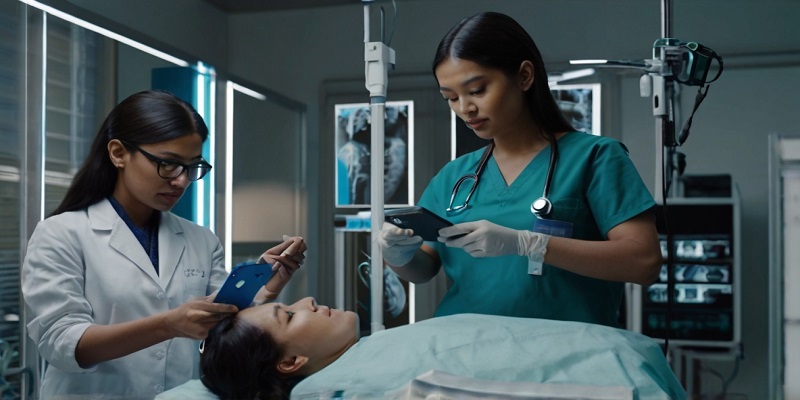Augmented Reality (AR) in Healthcare: Enhancing Patient Care and Medical Training

Augmented Reality (AR) has made significant strides in various industries, and healthcare is no exception. AR in healthcare is revolutionizing patient care and medical training by providing innovative solutions that improve accuracy, efficiency, and overall outcomes. This article delves into how AR is enhancing patient care and transforming medical training, exploring its applications, benefits, and future prospects.
Augmented Reality involves overlaying digital information onto the real world, creating an interactive experience that combines physical and virtual elements. In healthcare, AR technology is used to visualize complex medical data, guide surgical procedures, and provide immersive training experiences for medical professionals. This integration of digital information into the real world is proving to be a game-changer in the medical field.
Enhancing Patient Care with Augmented Reality
Accurate Diagnostics and Treatment Planning
AR technology plays a crucial role in improving diagnostic accuracy and treatment planning. By superimposing medical images onto a patient’s body, healthcare professionals can visualize internal structures without invasive procedures. This approach allows for precise diagnostics and personalized treatment plans, leading to better patient outcomes.
Surgical Precision and Safety
One of the most significant applications of AR in healthcare is in surgical procedures. Surgeons can use AR to overlay 3D images of a patient’s anatomy onto their bodies during surgery. This provides real-time guidance, enhancing precision and reducing the risk of errors. AR can also help in planning complex surgeries by allowing surgeons to practice and refine their techniques before the actual procedure.
Patient Education and Engagement
AR is a powerful tool for patient education and engagement. Patients can use AR applications to visualize their medical conditions and treatment options, making it easier to understand complex medical information. This improved understanding fosters better communication between patients and healthcare providers, leading to more informed decision-making and increased patient satisfaction.
Remote Consultations and Telemedicine
The COVID-19 pandemic has accelerated the adoption of telemedicine, and AR is enhancing this trend. AR can facilitate remote consultations by providing a more interactive and immersive experience. For example, doctors can use AR to examine patients remotely, guiding them through self-examinations and providing real-time feedback. This not only improves access to healthcare but also ensures that patients receive high-quality care, regardless of their location.
Transforming Medical Training with Augmented Reality
Interactive Medical Simulations
Medical training is another area where AR is making a significant impact. Traditional medical education relies heavily on textbooks and cadavers, which have limitations. AR provides interactive medical simulations that offer a more engaging and realistic learning experience. Trainees can practice procedures in a risk-free environment, gaining hands-on experience and confidence.
Enhanced Anatomy Learning
Understanding human anatomy is fundamental for medical professionals. AR enables students to explore detailed 3D models of the human body, which can be manipulated and studied from different angles. This interactive learning approach helps students grasp complex anatomical concepts more effectively than traditional methods.
Skill Assessment and Improvement
AR also aids in the assessment and improvement of medical skills. Training programs can use AR to track the performance of trainees, providing real-time feedback and identifying areas for improvement. This data-driven approach ensures that medical professionals are well-prepared and proficient in their skills before they enter clinical practice.
Continuing Education and Professional Development
In the rapidly evolving field of healthcare, continuous education and professional development are essential. AR provides ongoing learning opportunities for healthcare professionals, allowing them to stay updated with the latest advancements and techniques. This continuous learning approach ensures that healthcare providers deliver the best possible care to their patients.
Future Prospects of AR in Healthcare
Integration with Other Technologies
The future of AR in healthcare looks promising, with potential integration with other emerging technologies such as Artificial Intelligence (AI), Virtual Reality (VR), and the Internet of Things (IoT). These integrations can further enhance the capabilities of AR, providing more comprehensive and effective healthcare solutions.
Personalized Medicine
AR is also expected to play a pivotal role in the advancement of personalized medicine. By leveraging AR technology, healthcare providers can develop tailored treatment plans based on an individual’s unique medical data. This personalized approach can lead to better outcomes and more efficient use of healthcare resources.
Improving Access to Healthcare
AR has the potential to improve access to healthcare, particularly in remote and underserved areas. By facilitating remote consultations and providing immersive training experiences, AR can help bridge the gap between urban and rural healthcare services. This can lead to more equitable healthcare access and better overall public health.
Challenges and Considerations
While AR offers numerous benefits, there are challenges and considerations that need to be addressed. These include the high cost of AR technology, the need for robust data security and privacy measures, and the requirement for adequate training and support for healthcare professionals. Addressing these challenges will be crucial for the successful and widespread adoption of AR in healthcare.
Conclusion
Augmented Reality is transforming healthcare by enhancing patient care and revolutionizing medical training. Its applications in accurate diagnostics, surgical precision, patient education, and remote consultations are improving healthcare outcomes and patient satisfaction. In medical training, AR provides interactive simulations, enhanced anatomy learning, skill assessment, and ongoing professional development opportunities. The future of AR in healthcare looks promising, with potential integrations with other technologies and advancements in personalized medicine. While challenges exist, the benefits of AR in healthcare are undeniable, making it a vital tool for the future of medicine.





